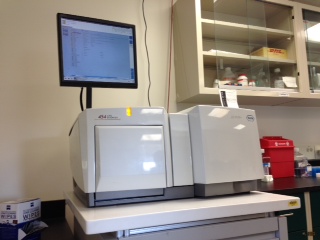Pyrosequencing by Synthesis
The 454 sequencer was the first next generation sequencer to market in 2005 with the GS20. Since 2005, Roche has made significant improvements to the 454 platform, specifically in terms of read length. To date, 454 GS FLX+ instrument comes closest to mirroring Sanger sequencing equivalency than any other next generation sequencing platform. The GS FLX+’s smaller counterpart, the GS Junior, is also not far behind in terms of read length.
The basic principle behind how 454 sequencing works is detection of light. First, libraries undergo emulsion PCR to clonally amplify single library molecules onto beads (DNA Capture beads). Beads are deposited into the microwells of a PicoTiterPlate (PTP). When a complementary nucleotide is incorporated during sequencing, 454 chemistry-specific enzymes use molecular byproducts (the first of which is ATP) as substrates. The last enzymatic reaction to take place in this cascade produces a flash of light which is captured in an image by a camera. The hundreds of images are converted into base-space by the instrument’s software.
To become a member of the 454 sequencing community, create an account at my454.com
454 Pyrosequencing Applications
There are several supported applications for 454 sequencing. Clicks the links below to get more information about each application:
- Whole Genome Sequencing
- Targeted Resequencing (Amplicon Sequencing)
- Metagenomics
- Transcriptome Sequencing
